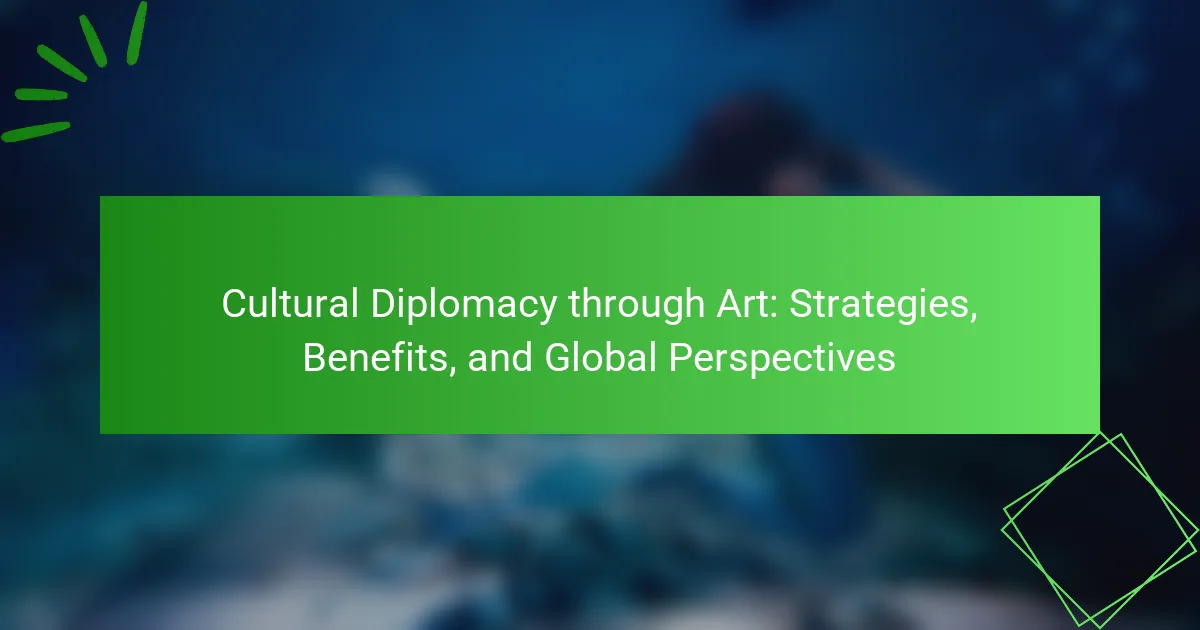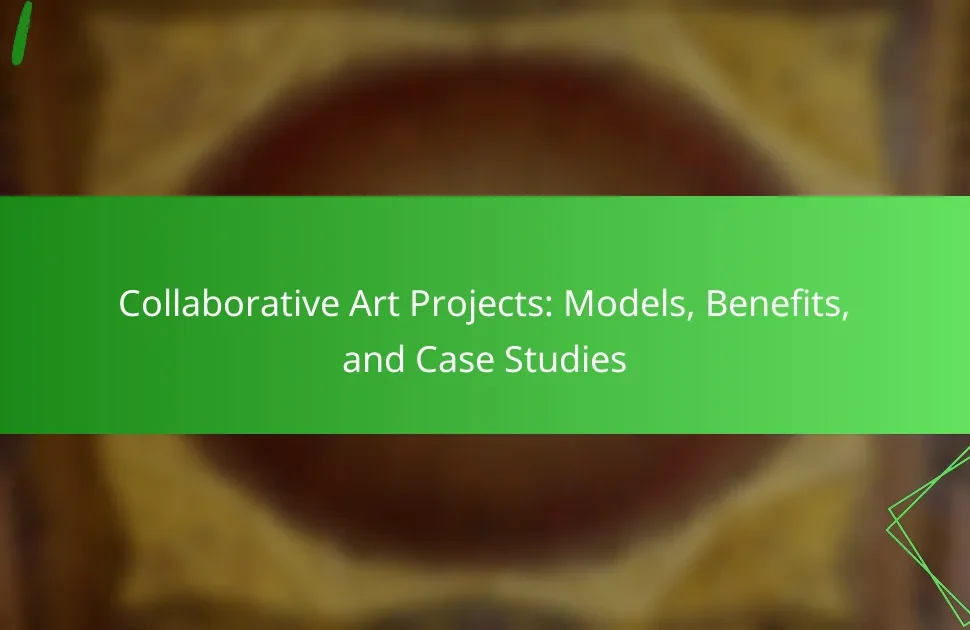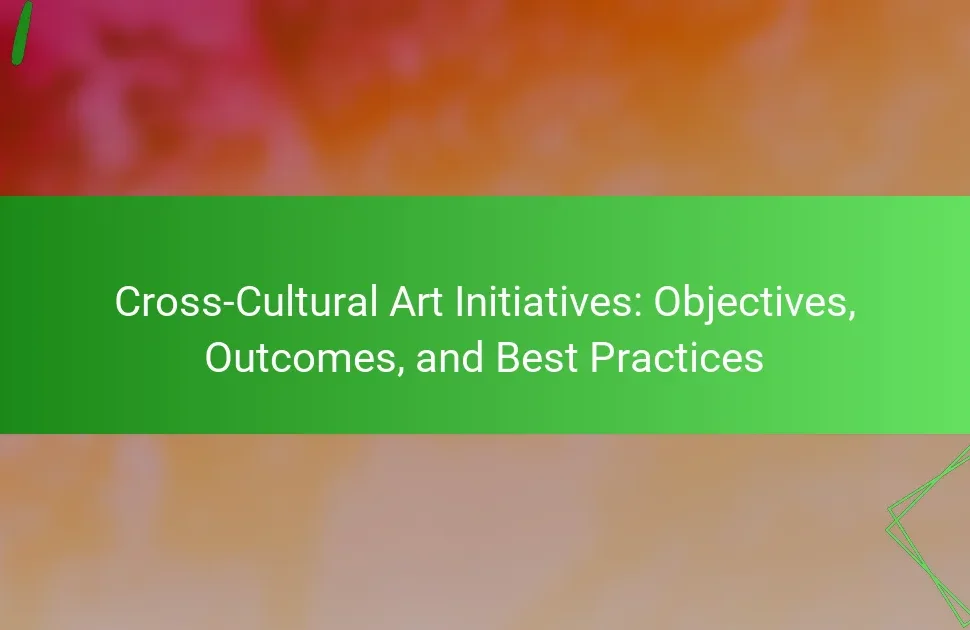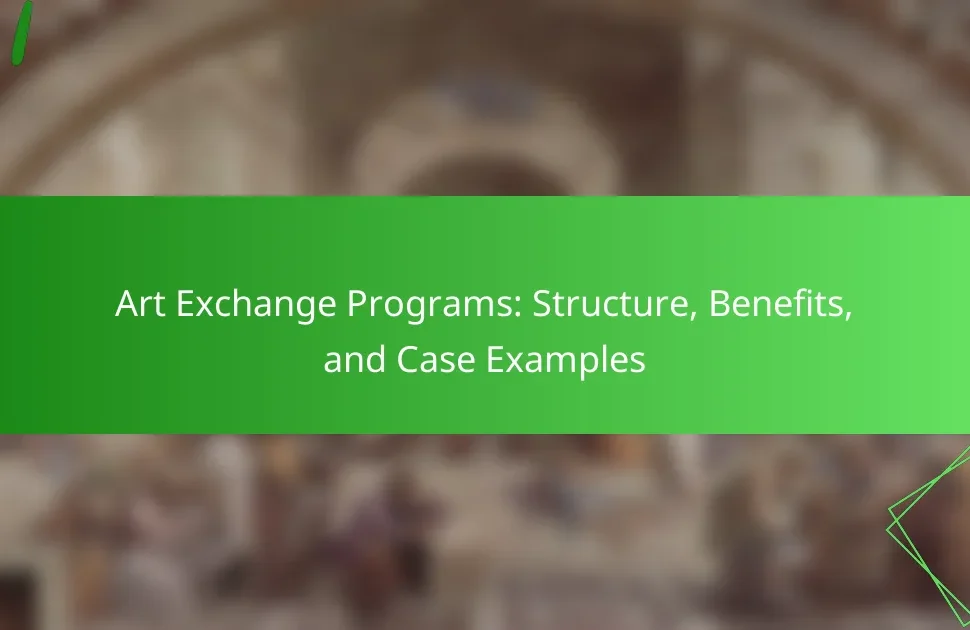Cultural diplomacy through art enhances mutual understanding and strengthens international relations. This article explores key strategies for implementation, highlights the benefits for participating nations, and examines diverse global perspectives. It also addresses challenges faced in cultural exchanges and emphasizes the importance of collaboration and technology in fostering sustainable initiatives.
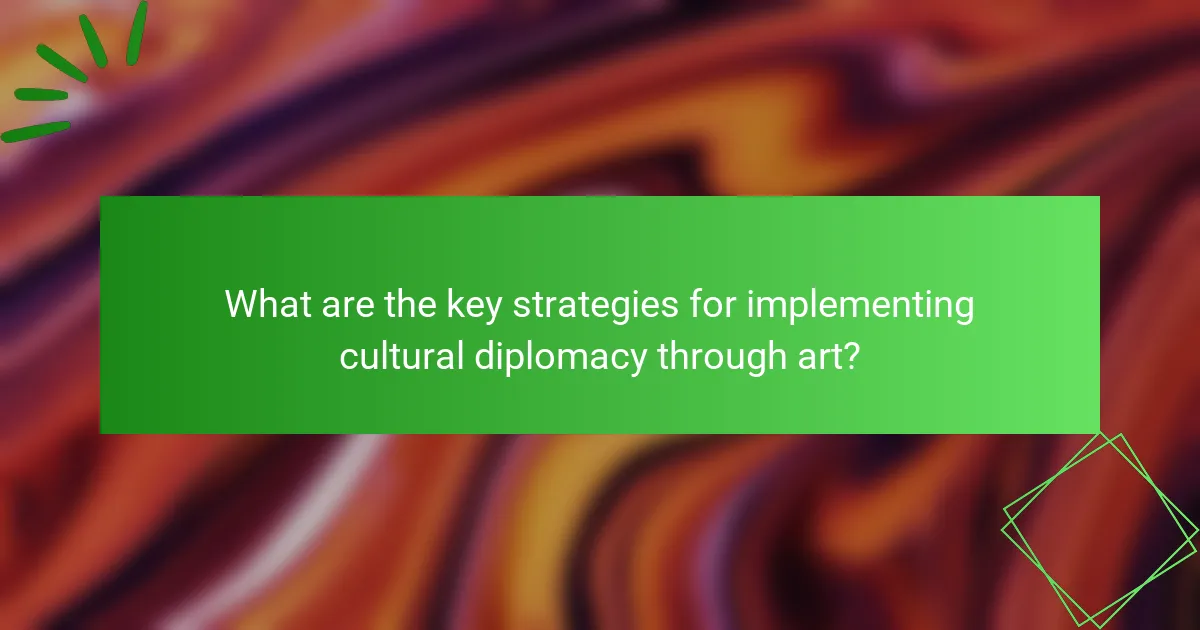
What are the key strategies for implementing cultural diplomacy through art?
Key strategies for implementing cultural diplomacy through art include fostering collaboration, promoting cultural exchange, and leveraging technology. Collaborative projects between artists from different countries enhance mutual understanding. Cultural exchange programs allow communities to experience diverse artistic expressions. Utilizing digital platforms can amplify reach and engagement, making art accessible globally. These strategies strengthen international relationships and promote peace through shared cultural experiences.
How do art exhibitions foster international relations?
Art exhibitions foster international relations by promoting cultural exchange and understanding among nations. They serve as platforms for dialogue, collaboration, and shared experiences. Through art, countries can express their values and narratives, creating connections that transcend political boundaries.
These exhibitions often feature diverse artistic expressions that highlight unique cultural attributes, fostering empathy and appreciation. For example, international art fairs can showcase contemporary works from various countries, allowing artists to engage with global audiences. This interaction can lead to partnerships and initiatives that strengthen diplomatic ties.
Moreover, art exhibitions can stimulate tourism and economic activity, enhancing mutual interests. Countries often leverage these events to attract visitors, showcasing their cultural heritage while promoting a positive national image.
Finally, art serves as a universal language, making it easier to bridge gaps between different cultures. By facilitating conversations through artistic mediums, exhibitions play a crucial role in enhancing global perspectives and fostering lasting relationships.
What role do cultural exchange programs play in diplomatic efforts?
Cultural exchange programs significantly enhance diplomatic efforts by fostering mutual understanding and collaboration. These initiatives promote dialogue through artistic expressions, enabling nations to share their heritage and values.
Art serves as a universal language, breaking down barriers and facilitating connections among diverse cultures. For example, art exhibitions and performances can bridge cultural gaps, allowing for shared experiences that strengthen international relations.
Additionally, cultural diplomacy through art provides unique opportunities for soft power influence. Countries can showcase their cultural achievements, enhancing their global image and fostering goodwill. As a result, these programs contribute to peaceful coexistence and collaborative problem-solving on global issues.
In summary, cultural exchange programs play a vital role in diplomacy by leveraging art to build relationships, enhance mutual respect, and promote international cooperation.
How can digital platforms enhance cultural diplomacy through art?
Digital platforms enhance cultural diplomacy through art by fostering global collaboration and increasing accessibility. They enable artists to share diverse cultural expressions, breaking geographical barriers. Platforms like social media and streaming services facilitate real-time interaction, allowing audiences to engage with art from different cultures. This exchange promotes mutual understanding and respect, vital for effective cultural diplomacy. Additionally, digital initiatives can amplify underrepresented voices, showcasing unique attributes of various cultures, which enriches the global artistic landscape.
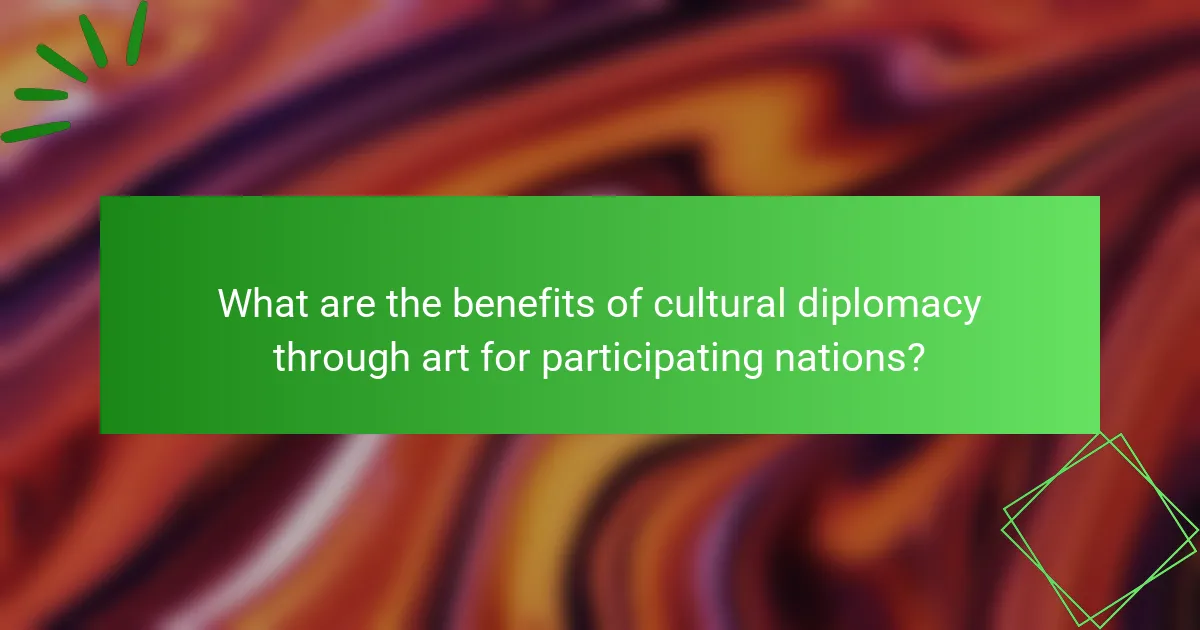
What are the benefits of cultural diplomacy through art for participating nations?
Cultural diplomacy through art fosters mutual understanding and strengthens international relations. Participating nations benefit by enhancing cultural exchange, promoting national identity, and fostering economic ties. Art initiatives can bridge gaps, allowing for dialogue and collaboration. As a result, nations can achieve greater social cohesion and global visibility.
How does cultural diplomacy improve mutual understanding between countries?
Cultural diplomacy improves mutual understanding between countries by fostering dialogue and collaboration through art. Artistic exchanges create shared experiences that transcend cultural barriers. Programs like international art exhibitions and cultural festivals promote appreciation of diverse perspectives. As a result, these initiatives enhance empathy and build lasting relationships between nations.
What economic advantages arise from engaging in cultural diplomacy?
Engaging in cultural diplomacy through art yields significant economic advantages. It fosters international partnerships, enhances tourism, and stimulates local economies through cultural exchanges. Art initiatives often attract investment and create job opportunities in creative industries. Additionally, cultural diplomacy promotes brand recognition, improving trade relations and economic ties between nations.
How can cultural diplomacy through art promote peace and conflict resolution?
Cultural diplomacy through art can effectively promote peace and conflict resolution by fostering understanding and empathy among diverse communities. Art serves as a universal language, bridging cultural divides and enabling dialogue.
Collaborative art projects can create shared experiences, allowing participants to express their perspectives and emotions. For example, murals created in conflict zones can symbolize hope and resilience, fostering a sense of community.
Furthermore, cultural exchanges through art can challenge stereotypes and misconceptions, promoting a more nuanced understanding of different cultures. This engagement can lead to lasting relationships and collaborations that transcend political boundaries.
In summary, cultural diplomacy through art not only enriches cultural understanding but also plays a vital role in building peace and resolving conflicts globally.

Which global perspectives shape cultural diplomacy through art?
Cultural diplomacy through art is shaped by diverse global perspectives that emphasize collaboration and mutual understanding. These perspectives include the promotion of cultural exchange, the use of art as a diplomatic tool, and the fostering of international relationships.
Countries leverage art to communicate values and narratives, enhancing their soft power. For instance, cultural festivals and exhibitions showcase national heritage, inviting dialogue and appreciation. Additionally, art initiatives can address social issues, promoting shared goals among nations.
Unique attributes of cultural diplomacy include its ability to transcend language barriers and engage audiences emotionally. This emotional connection can lead to deeper empathy and cooperation between cultures.
As a result, cultural diplomacy through art not only enriches cultural landscapes but also strengthens global ties, fostering peace and collaboration in an increasingly interconnected world.
How do different cultures interpret artistic expressions in diplomacy?
Different cultures interpret artistic expressions in diplomacy through unique lenses shaped by their historical, social, and political contexts. Artistic forms such as music, visual arts, and performance convey messages that resonate with cultural identities. For instance, traditional dances may symbolize peace in one culture while representing resistance in another.
The strategy of using art in diplomacy fosters mutual understanding and builds relationships. Art serves as a universal language, transcending barriers and allowing for emotional connections. Countries often leverage cultural events to showcase their heritage, inviting dialogue and collaboration.
Benefits of cultural diplomacy through art include enhanced soft power, improved international relations, and increased cultural exchange. As nations engage in artistic initiatives, they promote their values and perspectives, influencing global narratives.
Global perspectives on artistic expressions reveal diverse interpretations. In some cultures, art is a tool for activism, while in others, it emphasizes harmony. These varying interpretations enrich the global dialogue, highlighting the importance of context in understanding artistic diplomacy.
What are the varying impacts of cultural diplomacy in developed versus developing countries?
Cultural diplomacy impacts developed and developing countries differently, primarily due to resources and infrastructure. In developed countries, cultural diplomacy often leverages established institutions and funding, leading to extensive international collaborations and cultural exchanges. Conversely, developing countries may face challenges such as limited resources, which can hinder their ability to engage in cultural diplomacy effectively. However, they often utilize grassroots initiatives and local art forms to foster international relationships. These unique approaches can create authentic cultural connections that resonate more deeply with audiences. As a result, both contexts showcase the diverse strategies and benefits of cultural diplomacy through art.
How does the perception of cultural diplomacy differ across regions?
Cultural diplomacy perceptions vary significantly across regions due to historical, social, and political contexts. In Western countries, art often symbolizes freedom of expression and fosters collaboration. In contrast, regions with authoritarian governance may use art to project power or control narratives.
For instance, in the Middle East, cultural diplomacy through art can serve as a tool for soft power, aiming to reshape international perceptions. In Asia, nations like Japan emphasize traditional arts to promote cultural heritage and identity globally.
Moreover, the effectiveness of cultural diplomacy strategies is influenced by local audience reception. In Europe, art festivals often encourage dialogue and mutual understanding, while in Africa, art initiatives may focus on community development and social change.
Understanding these regional differences is crucial for designing effective cultural diplomacy strategies that resonate with diverse audiences.
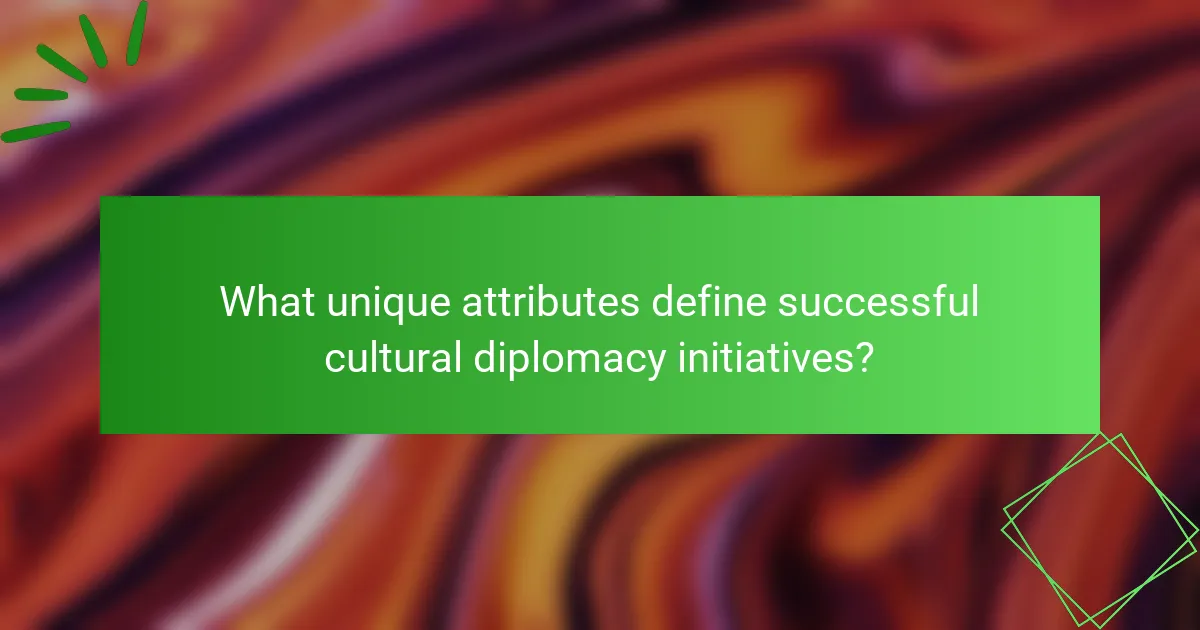
What unique attributes define successful cultural diplomacy initiatives?
Successful cultural diplomacy initiatives are defined by their ability to foster mutual understanding and respect through art. Unique attributes include collaboration with local artists, incorporation of diverse cultural narratives, and adaptability to different socio-political contexts. Additionally, they often leverage technology to enhance outreach and engagement, facilitating broader audience participation. These initiatives also emphasize sustainability, ensuring long-lasting impacts on communities and cultural exchanges.
Which notable art projects have exemplified effective cultural diplomacy?
Notable art projects that exemplified effective cultural diplomacy include the “Art for Peace” initiative, the “Cultural Olympiad” during the Olympics, and the “Global Art Project.” These projects foster international understanding and collaboration through artistic expression.
The “Art for Peace” initiative promotes dialogue and reconciliation in conflict zones, showcasing the transformative power of art. The “Cultural Olympiad” highlights the host country’s culture, engaging diverse audiences and enhancing global connections. The “Global Art Project” involves artists from various countries creating collaborative works, emphasizing shared human experiences.
These projects demonstrate how art can bridge cultural divides, promote mutual respect, and facilitate diplomatic relationships.
What innovative approaches have emerged in cultural diplomacy through art?
Innovative approaches in cultural diplomacy through art include collaborative projects, digital platforms, and community engagement initiatives. These strategies foster cross-cultural dialogue and enhance mutual understanding.
Collaborative projects, such as international art exhibitions, unite artists from diverse backgrounds, showcasing unique perspectives. Digital platforms enable global access to art, breaking geographical barriers. Community engagement initiatives involve local populations in artistic processes, promoting inclusivity and shared cultural experiences.
As a result, these approaches not only enhance cultural exchange but also strengthen diplomatic relationships between nations. They leverage art as a universal language, allowing for deeper connections and understanding across cultures.
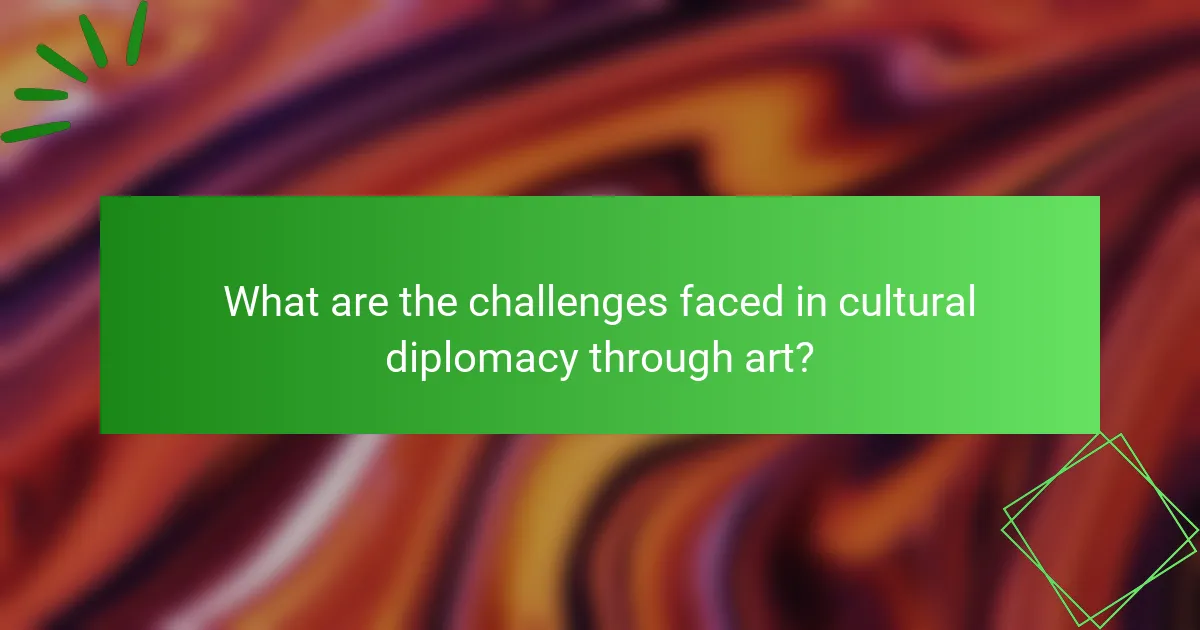
What are the challenges faced in cultural diplomacy through art?
Cultural diplomacy through art faces challenges such as political tensions, cultural misunderstandings, and funding limitations. These obstacles can hinder effective communication and collaboration between nations. Political climates often influence artistic exchanges, creating barriers to genuine engagement. Cultural misunderstandings may arise from differing interpretations of art, leading to miscommunication. Additionally, securing funding for art initiatives can be difficult, limiting the scope and reach of cultural diplomacy efforts.
How can cultural appropriation impact diplomatic relations?
Cultural appropriation can strain diplomatic relations by fostering resentment and misunderstanding. When one culture adopts elements from another without proper context, it can lead to perceived disrespect and cultural insensitivity. This tension may hinder collaboration and dialogue between nations. For instance, art and cultural expressions may become contentious topics, affecting international partnerships. As a result, fostering mutual respect and understanding through cultural diplomacy is essential for maintaining positive relationships.
What are the limitations of art as a tool for cultural diplomacy?
Art has limitations as a tool for cultural diplomacy, including subjectivity, misinterpretation, and accessibility issues. These factors can hinder effective communication and understanding. Cultural context influences perception, leading to varied interpretations that may not align with intended messages. Additionally, art may not reach all demographics, limiting its impact.

What best practices should be followed for effective cultural diplomacy through art?
Cultural diplomacy through art requires collaboration, respect for diversity, and effective communication. Engaging local artists fosters authentic cultural exchange. Additionally, utilizing social media amplifies global reach and impact. Establishing partnerships with cultural institutions enhances resource sharing and knowledge transfer. Lastly, evaluating outcomes ensures continuous improvement and relevance.
How can collaboration between artists and diplomats be optimized?
Collaboration between artists and diplomats can be optimized through structured partnerships, shared goals, and mutual understanding. Establishing clear communication channels enhances project alignment and fosters creativity. Joint initiatives can leverage artistic expressions to promote cultural narratives, strengthening diplomatic ties. Training programs can equip both parties with necessary skills, ensuring effective collaboration. Regular evaluations of projects can identify successes and areas for improvement, facilitating continuous growth in cultural diplomacy.
What common mistakes should be avoided in cultural diplomacy initiatives?
Common mistakes in cultural diplomacy initiatives include lack of clear objectives, insufficient understanding of local cultures, and neglecting to engage with local communities. These pitfalls hinder effective communication and can lead to misunderstandings. Additionally, failing to measure the impact of initiatives can result in wasted resources and missed opportunities for meaningful connections. Prioritizing authentic relationships and cultural sensitivity is essential for success.
How can feedback and evaluation improve cultural diplomacy projects?
Feedback and evaluation enhance cultural diplomacy projects by refining strategies and assessing impact. They provide insights into audience engagement and cultural relevance. Regular assessments allow for adjustments that align projects with community needs. This iterative process fosters stronger relationships and promotes sustainable cultural exchange.
